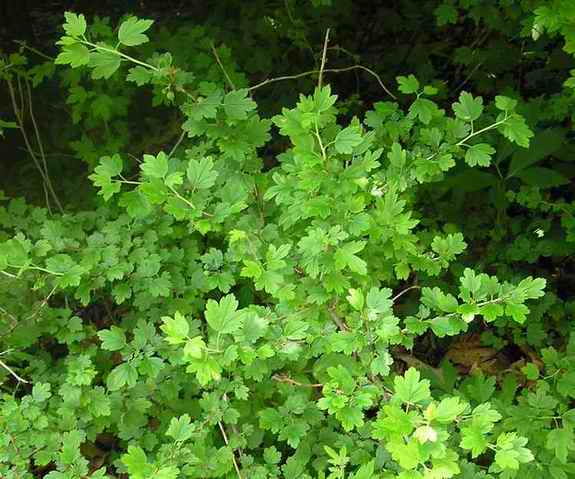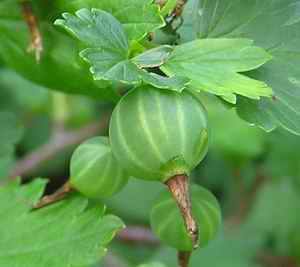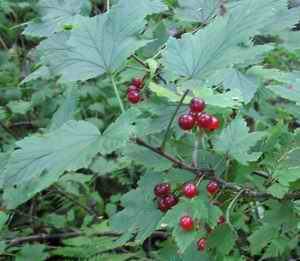|
Return to Hiker's Notebook Home Page
Common Name: Round Leaved Gooseberry, Appalachian gooseberry,
Feaberry, Feverberry, Carberry, Groseille a Maquereaux (French), Grozet
(Scotland), Krusbaar, Deberries, Goosegogs, Honeyblobs - the etymology of the
gooseberry is subject to conjecture. One theory is that it is a calque, an
anglicized version of the Dutch kruisbezie or the German krausbeere
which are the names for the shrub in the respective languages. The alternative
theory is that it is simply a compound English word formed from goose and
berry, possibly because geese eat the fruit.
Scientific Name: Ribes rotundifolia - The generic name is from the Arabic word ribas, which means either acid-tasting or rhubarb, depending on the reference. It is likely that the acid taste of rhubarb was the basis for that plant's Arabic name and the acidity of the Ribes berries was assigned to the genus. The species name is from the Latin rotundus meaning round and folium meaning leaf, referring to the general shape of the leaves.
Ribes is the only genus of the current family (Grossulariceae) and
consists of some 120 to 150 species of gooseberries and currants worldwide, 64
of which are North American. Gooseberries have been extensively cross bred so
that there are several hundred recognized cultivars; however, most were
derived from two original species, the European gooseberry (R. grossularia
from Groseille, French for Gooseberry) native to the Caucasus Mountains and
North Africa, and the
Gooseberries and currants are cultivated and harvested for their taste, an acidic tartness that is attributable largely to their high vitamin C content (black currants have the highest levels of all temperate fruits; 444% of the RDA in 100 grams). Ribes fruits have also been used medicinally; the juice was once considered a panacea for all inflammations. The noted English herbalist John Gerard referred to it as the "Feaberry" (a colloquialism for Feverberry) and prescribed that it was "greatly profitable to such as are troubled with a hot, burning ague." Currants and gooseberries are still widely used as a folk remedy for the treatment of cold symptoms, the high levels of vitamin C affording some benefit.
The dearth of gooseberries and currants in North America is due to a federal ban on the cultivation of plants of the Ribes genus that was established early in the 20th Century. The ban, which remained in effect until 1966, was due to the unique life cycle of the fungus Cronartium ribicola, commonly known as white pine blister rust, which was introduced on German eastern white pine seedlings (Pinus strobus) that were imported to eastern North America in 1898, though the fungus is thought to have originated in Asia. The white pine blister rust causes perennial cankers on five-needled species of the genus Pinus that are frequently pathogenic to young trees, killing them by girdling the bole.
The life cycle of C. ribicola requires two hosts; the fungus cannot spread from white pine to white pine but must be transformed through the intermediary Ribes plants. Starting the cycle with the pine, spores called spermatia are produced the first year at the canker site, their continued growth is what eventually kills the tree. The following year, aeciospores are produced at the edge of the canker that are dispersed by the air to reach the Ribes plants that generally occupy the same habitat. Aeciospores can only propagate on Ribes where they grow into the fungal mycelium. Within two weeks urediniospores, a third type, are produced on the Ribes that spread to other Ribes but not to white pine. The cycle is completed at the end of the second summer when C. ribicola shifts the Ribes production to telia that produce teliospores which in turn produce basidia and the resultant basidiospores that can only infest white pine with the characteristic canker. |


 American
gooseberry (R. hirtellum from hirtus which is Latin for hairy or
prickly) native to the northeastern United States and southern Canada. The
gooseberry and the closely related currant are prominent in European fruit
gardens where temperate climate prevails, notably the British Isles, the
Netherlands, Scandinavia and Russia. Gooseberry fruit range from small green
berries with unusual longitudinal stripes (above) found in eastern North
America to gray-green, yellow, red, and almost black depending on the cultivar
in Europe (primarily England). Red (left), white and black currants
predominate on the European mainland.
American
gooseberry (R. hirtellum from hirtus which is Latin for hairy or
prickly) native to the northeastern United States and southern Canada. The
gooseberry and the closely related currant are prominent in European fruit
gardens where temperate climate prevails, notably the British Isles, the
Netherlands, Scandinavia and Russia. Gooseberry fruit range from small green
berries with unusual longitudinal stripes (above) found in eastern North
America to gray-green, yellow, red, and almost black depending on the cultivar
in Europe (primarily England). Red (left), white and black currants
predominate on the European mainland.